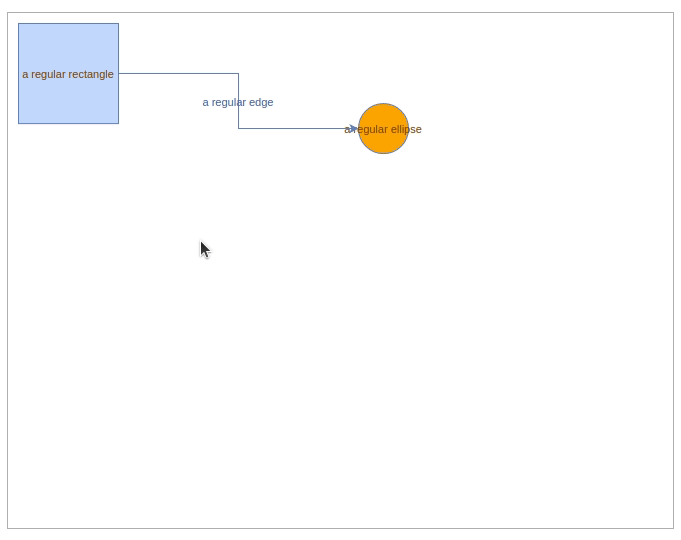maxGraph is a TypeScript library which can display and allow interaction with vector diagrams. At a high level, it provides:
- Nodes, also known as vertices which are typically represented by shapes like rectangles.
- Edges which can be lines and arrows which normally point between one node and another.
It provides many of the diagramming features which would be expected by a piece of presentation software like Microsoft® PowerPoint™ or LibreOffice® Impress such as being able to resize, move or rotate nodes, but has a stronger focus on automatic layout algorithms and applications of Graph Theory. It is suited towards software which requires finer-grained customization of functionality than off-the-shelf packages.
The maxGraph library uses no third-party software, it requires no plugins and can be integrated in virtually any framework (it's vanilla JS).
maxGraph is the successor of mxGraph which is now end of life.
At first, it provides the same features as mxGraph and adds
- TypeScript support
- maintained npm package
- modern modular, tree shakable, version of mxGraph to reduce the whole package size
New features will follow.
Chrome, Edge, Firefox, Safari, Chromium based browsers (Brave, Opera, ....) for mobile and desktop.
maxGraph is under active development and is in alpha. Please try it in your application and submit an issue
if you think that something is not working.
You can also test the project by running the Storybook examples or build the npm package locally to get the latest changes.
Install the latest version of maxGraph from the npm registry.
npm
npm install @maxgraph/core
yarn
yarn add @maxgraph/core
pnpm
pnpm add @maxgraph/core
Assuming your page defines an element with the id graph-container, the following will display a rectangle connected to an orange circle.
import {type CellStyle, Graph, InternalEvent} from '@maxgraph/core';
const container = <HTMLElement>document.getElementById('graph-container');
// Disables the built-in context menu
InternalEvent.disableContextMenu(container);
const graph = new Graph(container);
graph.setPanning(true); // Use mouse right button for panning
// Gets the default parent for inserting new cells. This
// is normally the first child of the root (ie. layer 0).
const parent = graph.getDefaultParent();
// Adds cells to the model in a single step
graph.batchUpdate(() => {
const vertex01 = graph.insertVertex(parent, null, 'a regular rectangle', 10, 10, 100, 100);
const vertex02 = graph.insertVertex(parent, null, 'a regular ellipse', 350, 90, 50, 50, <CellStyle>{shape: 'ellipse', fillColor: 'orange'});
graph.insertEdge(parent, null, 'a regular edge', vertex01, vertex02);
});You will see something like in the following maxGraph panning demo:
For more details, have a look at the storybook stories.
maxGraph is written in TypeScript and provides type definitions so maxGraph can be easily integrated into TypeScript projects.
maxGraph requires TypeScript 3.8 or greater.
For usage question, please open a new discussion on GitHub. You can also use
GitHub discussions for other topics like maxGraph development or to get the latest news.
Until we provide a complete documentation, you can check the mxGraph resources
- mxGraph documentation: Github pages branch. The key resources are the JavaScript user manual, the JavaScript examples and the JavaScript API specification.
- mxgraph tag on Stack Overflow. Please ensure your questions adhere to the SO guidelines, otherwise it is likely to be closed.
maxGraph APIs are not fully compatible with mxGraph APIs. The concepts are the same, so experienced mxGraph users should be able to switch from mxGraph to maxGraph without issues.
For a complete guide, see the dedicated migration page.
On 2020-11-09, the development on mxGraph stopped and mxGraph became effectively end of life.
On 2020-11-12, a fork of the mxGraph was created with a call to Contributors.
12 Nov 2020.
If you are interested in becoming a maintainer of mxGraph please comment on issue #1
Initial objectives:
- The first priority is to maintain a working version of mxGraph and its npm package
- The ambitious stretch goal is to refactor the codebase to create a modern modular, tree shakable, version of mxGraph to reduce the whole package size.
-- Colin Claverie
The project was then renamed on 2021-06-02 into maxGraph due to licensing issue.
Starting from the mxGraph 4.2.2 release, we
- moved code to ES9
- removed Internet Explorer specific code
- migrated to TypeScript, based on the work initiated in typed-mxgraph
- migrated the examples to Storybook
Ensure you don't have the former mxGraph tags locally (see #92 fore more details):
git fetch --all --tags --prune
In the project root directory, execute
$ npm installTo watch the core package, execute
$ npm run devand select @mxgraph/core.
To run the html(vanilla-js) version of Storybook, execute
$ npm run devand select @mxgraph/html.
Since both commands are in watch mode, so it's recommended to open two terminals and run them separately. When a file is saved from the core package, the html storybook will be automatically updated.
Run
- from the project root:
npm install - then, from the
packages/corefolder:npm pack
The packages/core folder or the generated packages/core/maxgraph-core-***.tgz file are now ready for use in an external project, using npm link or npm install.
Examples of use can be found in the maxgraph-integration-examples repository.
See the dedicated release page.

